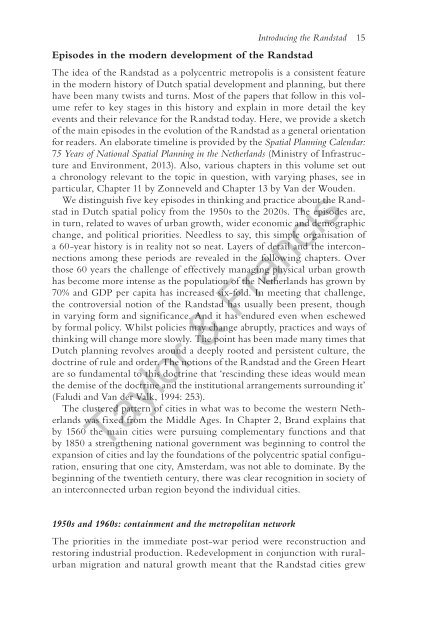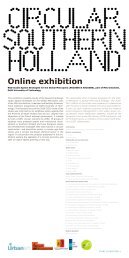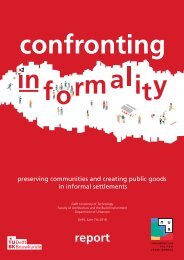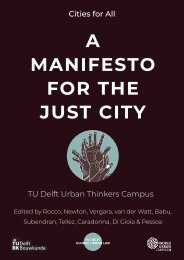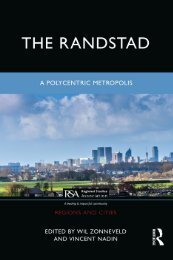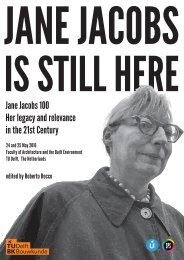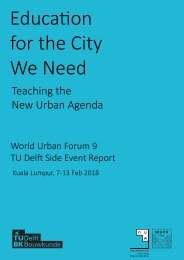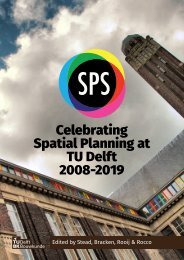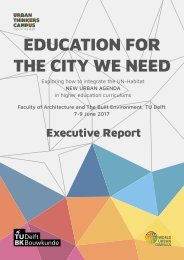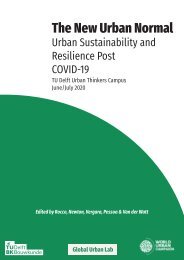The Randstad, a polycentric metropolis, by Vincent Nadin & Will Zonneveld. (Introduction Chapter)
Introduction The Randstad is a cluster of relatively medium-sized and small cities in the western Netherlands that encircles an expanse of largely open land. It is undoubtedly an important urban region, hosting in an area of about 7,000 km2, Europe’s largest seaport, third busiest airport, second largest Internet Exchange, and about 7 million people. But the Randstad is much more than this. Since the 1960s, it has acquired distinction as the archetypal polycentric metropolis, an integrated urban ring around a Green Heart, with the status of a world-class metropolitan region. There is a presumption too, that government has played an inf luential role in strengthening the polycentricity of the region, especially through its renowned capability in spatial planning. But the reality of the polycentric Randstad as opposed to the idea is controversial, as is the role of spatial planning. Do the interconnections between the four main cities – Amsterdam, The Hague, Rotterdam, and Utrecht – and the many smaller settlements in-between function as an integrated polycentric region? Does the economic and social performance of the combined whole of the Randstad add up to more than the sum of its parts? Advocates point to the apparent complementarity of the main cities with a tendency for business and financial functions to be centred in Amsterdam, port and logistics in Rotterdam, governance and international justice in The Hague, and research and development in Utrecht. Critics draw attention to the relatively limited f lows of commuters between the cities, and the concentration of the daily urban f lows within the individual city-regions, which they argue operate independently.
Introduction
The Randstad is a cluster of relatively medium-sized and small cities in the
western Netherlands that encircles an expanse of largely open land. It is undoubtedly
an important urban region, hosting in an area of about 7,000 km2,
Europe’s largest seaport, third busiest airport, second largest Internet Exchange,
and about 7 million people. But the Randstad is much more than
this. Since the 1960s, it has acquired distinction as the archetypal polycentric
metropolis, an integrated urban ring around a Green Heart, with the status of
a world-class metropolitan region. There is a presumption too, that government
has played an inf luential role in strengthening the polycentricity of the
region, especially through its renowned capability in spatial planning.
But the reality of the polycentric Randstad as opposed to the idea is controversial,
as is the role of spatial planning. Do the interconnections between the
four main cities – Amsterdam, The Hague, Rotterdam, and Utrecht – and
the many smaller settlements in-between function as an integrated polycentric
region? Does the economic and social performance of the combined
whole of the Randstad add up to more than the sum of its parts? Advocates
point to the apparent complementarity of the main cities with a tendency for
business and financial functions to be centred in Amsterdam, port and logistics
in Rotterdam, governance and international justice in The Hague, and
research and development in Utrecht. Critics draw attention to the relatively
limited f lows of commuters between the cities, and the concentration of the
daily urban f lows within the individual city-regions, which they argue operate
independently.
You also want an ePaper? Increase the reach of your titles
YUMPU automatically turns print PDFs into web optimized ePapers that Google loves.
Introducing the <strong>Randstad</strong> 15<br />
Episodes in the modern development of the <strong>Randstad</strong><br />
<strong>The</strong> idea of the <strong>Randstad</strong> as a <strong>polycentric</strong> <strong>metropolis</strong> is a consistent feature<br />
in the modern history of Dutch spatial development and planning, but there<br />
have been many twists and turns. Most of the papers that follow in this volume<br />
refer to key stages in this history and explain in more detail the key<br />
events and their relevance for the <strong>Randstad</strong> today. Here, we provide a sketch<br />
of the main episodes in the evolution of the <strong>Randstad</strong> as a general orientation<br />
for readers. An elaborate timeline is provided <strong>by</strong> the Spatial Planning Calendar:<br />
75 Years of National Spatial Planning in the Netherlands (Ministry of Infrastructure<br />
and Environment, 2013). Also, various chapters in this volume set out<br />
a chronology relevant to the topic in question, with varying phases, see in<br />
particular, <strong>Chapter</strong> 11 <strong>by</strong> <strong>Zonneveld</strong> and <strong>Chapter</strong> 13 <strong>by</strong> Van der Wouden.<br />
We distinguish five key episodes in thinking and practice about the <strong>Randstad</strong><br />
in Dutch spatial policy from the 1950s to the 2020s. <strong>The</strong> episodes are,<br />
in turn, related to waves of urban growth, wider economic and demographic<br />
change, and political priorities. Needless to say, this simple organisation of<br />
a 60-year history is in reality not so neat. Layers of detail and the interconnections<br />
among these periods are revealed in the following chapters. Over<br />
those 60 years the challenge of effectively managing physical urban growth<br />
has become more intense as the population of the Netherlands has grown <strong>by</strong><br />
70% and GDP per capita has increased six-fold. In meeting that challenge,<br />
the controversial notion of the <strong>Randstad</strong> has usually been present, though<br />
in varying form and significance. And it has endured even when eschewed<br />
<strong>by</strong> formal policy. Whilst policies may change abruptly, practices and ways of<br />
thinking will change more slowly. <strong>The</strong> point has been made many times that<br />
Dutch planning revolves around a deeply rooted and persistent culture, the<br />
doctrine of rule and order. <strong>The</strong> notions of the <strong>Randstad</strong> and the Green Heart<br />
are so fundamental to this doctrine that ‘rescinding these ideas would mean<br />
the demise of the doctrine and the institutional arrangements surrounding it’<br />
(Faludi and Van der Valk, 1994: 253).<br />
<strong>The</strong> clustered pattern of cities in what was to become the western Netherlands<br />
was fixed from the Middle Ages. In <strong>Chapter</strong> 2, Brand explains that<br />
<strong>by</strong> 1560 the main cities were pursuing complementary functions and that<br />
<strong>by</strong> 1850 a strengthening national government was beginning to control the<br />
expansion of cities and lay the foundations of the <strong>polycentric</strong> spatial configuration,<br />
ensuring that one city, Amsterdam, was not able to dominate. By the<br />
beginning of the twentieth century, there was clear recognition in society of<br />
an interconnected urban region beyond the individual cities.<br />
Taylor & Francis<br />
1950s and 1960s: containment and the metropolitan network<br />
<strong>The</strong> priorities in the immediate post-war period were reconstruction and<br />
restoring industrial production. Redevelopment in conjunction with ruralurban<br />
migration and natural growth meant that the <strong>Randstad</strong> cities grew


